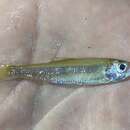Diagnostic Description
provided by Fishbase
Diagnosis: Body moderate or fairly deep, its depth 23-30% of standard length; 1 or more scutes beginning in front of base of first pectoral finray, with 11-16 pre-pelvic and 8-11 post-pelvic scutes, and a total of 20-25 scutes, first pre-pelvic scute always longer and better developed than following scutes lacking ascending arms; lower jaw slightly projecting, teeth at symphysis large in large specimens; pre-maxilla teeth well-developed, fairly straight and outward pointing, an indented toothless gap at centre of jaw; lower gillrakers 24-37, equal to or longer than corresponding gill filaments; silver stripe along flank (Ref. 188, 2244, 81269, 81631). It resembles Pellonula leonensis, which has small and inward-curving teeth and no pre-pectoral scutes (Ref. 188, 81269, 81631). The absence of large canine teeth in the upper jaw distinguishes it from Odaxothrissa (Ref. 188).Description: Body moderate or fairly deep, its depth 23-30% of standard length (Ref. 188, 2244). Head length about 30% of standard length (Ref. 2244). Lower jaw projecting, with well-developed teeth, but no enlarged canine teeth; maxillary extending to below anterior border of eye or a little beyond (Ref. 1878, 2244, 3022). A group of teeth on each side of the palatinum; generally 3 rows of teeth on the tongue; conical teeth relatively well developed on the dentary and pre-maxillary; pre-maxillary teeth are directed towards the outside of the mouth; length of supra-maxillary and width of maxillary respectively 58.6-75.8% and 16.2-22.0% of maxillary length, whose base bears up to 40 small conical teeth (Ref. 2244). First gill arch with 34-54 gill rakers, of which 24-37 on the lower limb, generally longer than the corresponding filaments on the first gill arch (Ref. 2244, 2849, 81269, 81631). Dorsal fin with 15-19 rays, the first dorsal-fin ray slightly in front or behind the insertion of the pelvic fin; anal fin with 16-21 rays; pectoral fin with 12-18 rays; pelvic fin with 8 rays; length of pectoral fin generally more than half the pectoral-pelvic fin distance; caudal fin deeply forked, with pointed lobes (Ref. 1878, 2244, 2849, 81269, 81631). Cycloid scales; 38-48 scales on longitudinal series; 13-14 scales in transverse series (Ref. 1878, 2244, 3032). First pre-pelvic scute better developed and longer than following ones lacking ascending arms and located at isthmus in front of the base of the first pectoral fin ray; 10-16 pre-pelvic scutes and 8-11 post-pelvic scutes (Ref. 188, 2244, 2849, 81269, 81631). Vertebrae 42-43; with 21-26 abdominal vertebrae, 17-23 caudal vertebrae and 10-12 predorsal bones (Ref. 2244, 41578).Colouration: Ground colour in preserved specimens variable from yellow-brown to yellow-gray; operculum, ventral region and flanks usually lighter (Ref. 2244, 2849, 81269, 81631). Silver stripe along flank (Ref. 188).
Migration
provided by Fishbase
Anadromous. Fish that ascend rivers to spawn, as salmon and hilsa do. Sub-division of diadromous. Migrations should be cyclical and predictable and cover more than 100 km.
Morphology
provided by Fishbase
Dorsal spines (total): 0; Dorsal soft rays (total): 15 - 19; Analspines: 0; Analsoft rays: 16 - 21; Vertebrae: 42 - 43
Trophic Strategy
provided by Fishbase
Found in rivers and streams (Ref. 188). It forms large schools in lower courses of rivers (Ref. 2244, 43836), and is very abundant in brackish water habitat (Ref. 86940).
Biology
provided by Fishbase
Found in rivers and streams (Ref. 188). It forms large schools in lower courses of rivers (Ref. 2244, 43836), and is very abundant in brackish water habitat (Ref. 86940).
Importance
provided by Fishbase
fisheries: subsistence fisheries

